Table of contents
- What is SEO Content Writer Software?
- NeuronWriter SEO Writing Assistant
- Neuraltext V2.0 SEO Writing Tool
- Blogely For SEO Content Writing and Blog Publishing Software
- AISEO AI Content Creator and Keyword Research
- Squirrly SEO – Keyword Research and SEO Content Optimizer
- WriterZen SEO and Content Editor Software and Keyword Research Tool
Google’s search engine is getting smarter at figuring out what users want when they look up a phrase in their never-ending quest for information. As the Google algorithm gets more skilled at figuring out what’s good and what’s not, the pressure is on for SEO content creators to keep up.
The search industry runs on supply and demand like any other, and if your content doesn’t supply the goods, the search engines will drop your article out of the search results. When was the last time you made it to page two, let alone page three, when searching for a new pair of running shoes?
In short, if you want the top spot, you will need to invest in a quality SEO content optimization tool to up your content marketing game.
You don’t want to waste your time creating SEO content that will never see the light of day. The following affordable SEO content writer software all have features that make writing SEO content a lot more straightforward and ensure you don’t leave anything out.
I am a participant in quite a few affiliate programs that I believe can add value to your business. If you don’t know what that means, you can read more about it in my privacy policy.
What is SEO Content Writer Software?
You need to be more than just a great writer creating articles with useful content readability to get your articles to rank. You also need to ensure every piece of content is optimized for the search engines using sound SEO principles.
What is SEO?
Before you can understand what SEO content writer software is, it helps to know a little more about search engine optimization.
SEO refers to the processes that improve a website’s chance of appearing in the organic search results listings.
There are a lot of elements to get right with SEO, such as page speed (how fast your site loads), outbound links, off-page inbound links (backlinks), and social media engagement, but SEO content creation software focuses mostly on the articles you will publish on your website.
The primary goal of SEO content writing is to increase the volume of organic traffic to your website, which refers to visitors who arrive from a search result that is not a paid ad.
You need to write engaging content that humans will appreciate, but you should also ensure your content can be understood by the search engines so they can accurately rank it for the phrases people are using to find your business.
For example, if you were a company selling new TVs, it wouldn’t do your business any good if the visitors on your site arrived after searching for TV repair.
Using a quality content editor to get all your SEO ducks in a row means you will not only increase the volume of traffic to your site, but you will also attract the kind of traffic that is more likely to result in a sale.
As you can see, content that is properly optimized can be a tricky business. Fortunately, there is a growing pool of content writing tools for SEO to help you craft the best possible article.
Content Writer Software to Help You Rank
None of the tools below will help you become a good writer; skillful writing only comes with practice. What these writing tools will do is guide you into producing the type of content your readers need while also optimizing it so it’s worthy of a first-page ranking.
Each tool helps you follow practical SEO principles while writing content to ensure that Google and the other search engines can understand and rank your articles.
This way, they are more likely to serve up the most relevant content to their searchers; hopefully, it will be yours.
I regularly make use of the following content optimization tools to craft content for myself and my clients.
A few have extra features, like keyword research, which may be good enough to take the place of some of your other SEO tools and save you money. Let’s check out each of them so you can see for yourself which ones will work best for your workflow.
NeuronWriter SEO Writing Assistant
Out of all the SEO content creation software I use, NeuronWriter is the one that is most often compared to Surfer SEO and is considered by many to be just as good.
From my experiments as a guest user of Surfer SEO for clients, I would tend to agree that the results are similar.
For example, an article scoring 70 in NeuronWriter scored 66 in SurferSEO.
Adding two recommended phrases in Surfer moved the needle by 10 points, while the same additions in NeuronWriter did nothing. It seems that NeuronWriter is tougher on SEO scores.
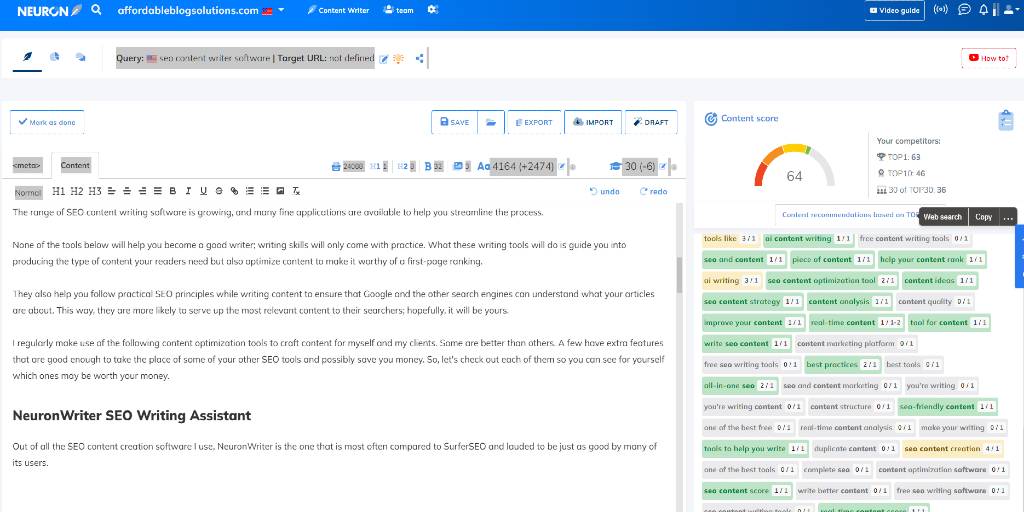
NeuronWriter stores your content in projects, so your domain name becomes a folder for all articles destined for a particular website.
How many projects you can have depends on your plan, which starts at 2 for the lowest tier, and goes up to fifty projects (websites) for the Diamond plan.
The limits are acceptable for the average blogger but might be a bit of a tight squeeze if you run an agency or have a lot of different clients.
To get around this, NeuronWriter developers recommend creating a dummy domain as a project to store articles for many different clients. Prolific writers will still bump up against the analysis limits.
NeuronWriter’s Main Features
Once you have your project set up, you are ready to start your first article. NeuronWriter is not in any way a keyword research tool for checking out bulk lists of keywords at a time. You will need to research elsewhere to find the best phrase to target. I recommend WriterZen or UberSuggest.
After you enter your target phrase, the NeuronWriter content optimization software then casts its net to the web to analyze the top results and return a list of the top 30. Each page is analyzed according to how well optimized it is for the phrase, so you can write better content to beat it.
There may be big websites in your list like Amazon or Walmart that are not direct competitors, so you can ask NeuronWriter to dismiss these as irrelevant.
The software then processes all the content for the next step in content creation and delivers a list of headers down to H3. Enter the Draft mode to develop your content outline and improve your chances of writing content that ranks.
Your content quality is scored as you write, and you can easily see what phrases you have yet to add to your article. It’s color-coded according to the frequency of use for each phrase and how many times they are mentioned in your competitor’s articles.
Grey means you haven’t used a phrase, green represents an optimal frequency, yellow is borderline okay, and red means you need to check that phrase for keyword stuffing.
The numbers next to the phrase show how many times it appears in your text versus the recommended number.
Click the clipboard icon in the top-right corner for a detailed analysis and complete SEO breakdown of how well optimized your article is. Clicking on a phrase provides you with even more information.
You can highlight that phrase in your text so it’s easier to locate and change, get usage examples, change the usage numbers, and exclude it from the list if it’s not relevant.
NeuronWriter is one of the best SEO content writing tools available. If you are looking for an alternative content creator that is like SurferSEO, then this is the one you want. It’s cheaper than Surfer, and the limits are more generous.
Plus, if you like using AI, NeuronWriter provides AI credits each month. SurferSEO can integrate with Jasper.ai if you need an AI assistant built in, but it’s an extra monthly expense to use this feature. When you add it up, NeuronWriter makes much better value.
Neuraltext V2.0 SEO Writing Tool
NeuralText recently revamped the editor, making it almost unrecognizable from the original product while leaving the functionality intact. The application is much easier to navigate, so you can focus on your work rather than fight the interface.

NeuralText Main Features
The main editing area takes up a large portion of the left-hand side of your browser, while all the research and competitive analysis reside on the right. Whatever data you need is just a mouse click away.
You need to start a new project before creating your article. I use client user names as titles for projects, but a blogger could just as easily use a category name. You can think of each project as a folder to store a group of related documents.
The advanced tab is where you enter your target keyword, location, and source (Google Search or Google News). You also select a checkbox to tell NeuronText to go off and find a bunch of related keywords.
NeuralText will then go out and analyze the top 20 results. The first tab on the right-hand panel lists each SERP result and the word count. You can access an entire page’s content by clicking on the down arrow to see how the content is constructed with heading tags. NeuralText also attempts to pull statistics from the results, which is a handy resource when you need to cite statistics and sources.
There is a wealth of information hidden away in the topics tab. You can sort by:
- Subtopic, where terms are listed in order of frequency, used
- Clusters that lump related terms together
- SEO score (the top SEO score is not necessarily the top result)
- Headers that show you how many times a term is used in headers in the top results
- Titles that show you how many times a term is used in the title tag
If you asked NeuralText to research additional keywords when creating your article you will access them in the Related tab. The software creates a list of keywords it thinks are related to the current topic along with a trending graph, search volume, and keyword difficulty score. It’s fairly basic compared to other keyword research tools, so NeuralText isn’t yet the all-in-one SEO tool we’ve all been waiting for. However, it can provide useful insight into other terms you might want to weave into your article.
You get more information related to the analysis of the search results towards the bottom of the editor. You can see the average SEO score for the top 20 results, the average word count to give you an idea of the length you should be targeting, and a readability score showing you how easy or hard your article will be to read.

One of NeuralText’s selling points is its AI content writing features. I can’t tell you much about these as I don’t have much time for AI other than as another tool for research, or to trigger the creative juices when I’m stuck. It’s much more productive to play around with AI for ideas than to stare at a blank screen waiting for something, anything to pop into your head.
NeuralText scores your text as you write. The more terms you add from the research on the right, the higher your score should go. You can’t guarantee a first-page result, but at least you have some idea of where you stand against the competition and can give them a run for their money.
When your fully optimized article is complete, and you have the best score you can possibly coax out of it, it’s time to download it. NeuralText is perhaps the most limited in terms of publishing options because you only have HTML. If that’s not suitable, you can still cut and paste.
NeuralText V2.0 is missing a way to add links or images, which I find odd, and doesn’t have a plagiarism checker. You will need to add links manually and use another source to check for originality.
You can get started using NeuronWriter for free to test out its features with up to three content analyses and three keyword reports.
Blogely For SEO Content Writing and Blog Publishing Software
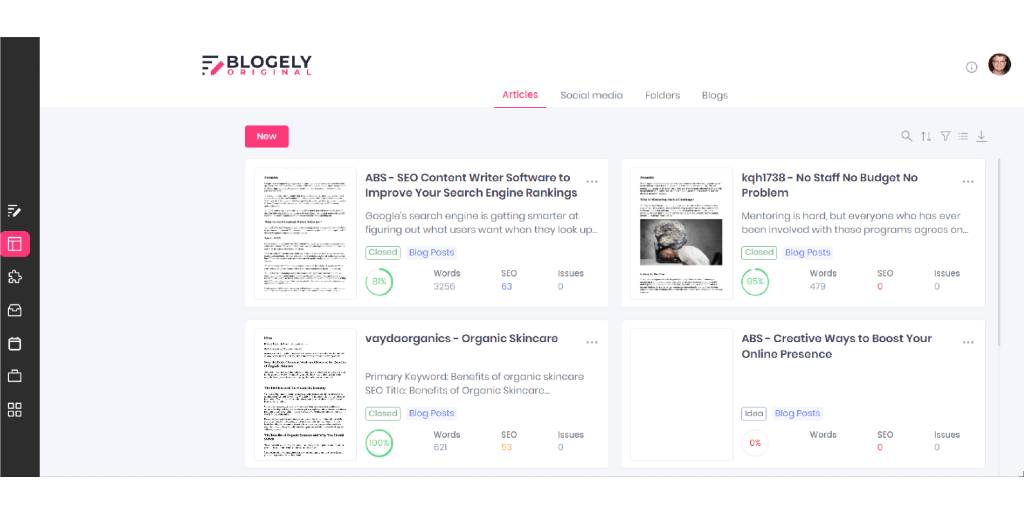
I love using Blogely. It has so many features it can take a little while to get your head around them all. As far as SEO content writer software goes, Blogely does a bit of everything.
Keyword research, topic research, and competitive analysis are all there. The latter may be in a watered-down format compared to the likes of Ahref and SEMRush, but it’s still useful.
Freelancers who opt for some of the higher tiers will get access to a portfolio page where they can show off their writing prowess to potential clients.
Blogely Main Features
As I mentioned, Blogely does a little bit of everything to help with your content creation, but its main strengths lie in its research, content creation, and publishing capabilities. These are pretty powerful when you stack them up against other SEO content creation software.
Content Creation – Blogely can take over as your main writing application, with everything you need to create any type of article content. Add images, format text, manage links and publish with a couple of clicks when you’re done. You can quickly switch between a text view and an HTML view to ensure the code is tidy.
SEO Content Scoring System – The SEO tab is essentially an SEO content checklist that keeps track of critical SEO best practices, such as keywords in the H1 and H2, meta description, alt tags, and more. The article score is based on how many of these items you have included or missed. When you use this feature to improve your content, it’s all but impossible to miss any of the important bits for good SEO.
Asset’s Library – If you are anything like me, you are forever recording notes and web addresses and then wondering where you put them. Each article you create in Blogely becomes a container for your research, notes, images, and keywords, so you can never lose track of which snippet of information goes with which article.
AI Writing Assistant – When writer’s block has you staring at a blinking cursor on a blank page, the AI assistant can kickstart the creative process. AI writing software in Blogely is a credits-based system, so it’s not technically part of your plan. Credits are affordable, though, and they never expire. Blogely also plays well with other apps such as WordTune, Grammarly, and Linguix, further enhancing your writing through AI without leaving the app.
Research Docs – Perform a keyword search in a research doc and get instant access to your top competitors in the search results. Add information to your research article, complete with links so you don’t lose track of where that valuable little snippet of information came from.
Review your competitor’s article structure and make yours better. You can even choose to ignore a URL if it’s not a direct competitor to reduce distractions or add additional URLs that didn’t come up in the original search.
Project Management Features – Schedule your articles to be published with Blogely’s handy calendar feature. Instantly preview what’s published and what you still have to work on. There is also a workflow management tool for each article so you and your team members are updated on what needs to happen next.
Blog Imports – Create an instant backup of your site’s articles by importing them directly into Blogely. I find this a super handy feature for when you need to go through and update your older articles, especially when you combine it with the calendar.
Plagiarism Checker – The plagiarism checker is another credit-based system that’s available on top of your plan. A 1,000-word article costs about thirty cents to check, so it’s affordable. Plus, you get a nicely formatted report to send to clients as proof.
Keyword Research Tools and Competitive Analysis – Blogely creates a heatmap for whatever keyword and related keywords you want to know more about. It’s not up to Ahrefs or SEMRush, or Ubersuggest standards, but it’s a nice feature for writers who don’t have access to more advanced (and expensive!) tools.
Each result in the SERPs has a corresponding number inside a colored circle. Green is easy, yellow is a little harder, blue is challenging, and red is a no go until your site has some authority. Click on a circle to review how well optimized a page is for that keyword, plus get a tally on backlinks and internal links.
Unfortunately, Blogely does not provide a real-time content score similar to SurferSEO and the myriad tools like it. It’s a significant downside if you are searching for one tool for content writing that does everything.
Blogely has a small but active development team, and Gennady, the founder, seems like a dedicated chap. Updates aren’t super regular, but they do happen. The Facebook group is small and not that active, but support through their chat interface is always pretty good and comes with personal service. I enjoy using the app and look forward to the new features they have planned.
I’ll be very disappointed if it doesn’t stay around for the long haul. Check out Blogely and get started for free [affiliate link]. Try out its features and see if it’s right for you. Even if you don’t find a use for all of its tools, I’m sure you will find a feature or two that makes Blogely worth the admission price.
AISEO AI Content Creator and Keyword Research
When I first accessed AISEO, the content creation software showed its promise as an excellent research tool even though it was very rough around the edges.
Things have significantly improved over the last few months and the interface doesn’t make me want to run away. The UX is now clean and super intuitive.
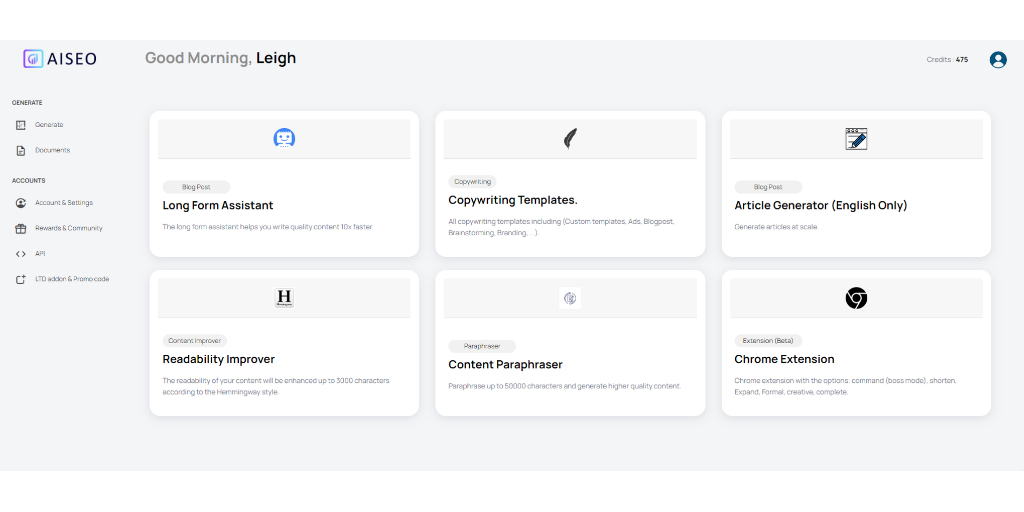
AISEO Main Features
Like most of the SEO content optimization tools in this article, AISEO’s focus is on saving time with help from an AI writer. However, the SaaS application is perfectly serviceable as a tool that helps you create content that ranks. or at least improves your chances.
AISEO provides a number of tools to help you create content, including a long-form assistant, access to a bunch of AI copywriting templates, an article generator, and a readability enhancer that uses the Hemingway algorithm.
I spent most of my time in AISEO using the long-form assistant. The interface is unique, but the tool shares many similarities with other content writing tools such as SurferSEO and NeuralText. You’ve got the main portion of the screen for editing, while the right-hand columns host the SERP’s data.
SEO Score – Your text is scored against the competition as you write. Underneath your SEO score, you can see the word count and the number of words you need to aim for to match the pages appearing in the search results. AISEO also tallies your headers, paragraphs, and images and compares what you have against your competitors.
Google NLP Phrases – Further down is a list of Google’s NLP terms that AISEO recommends you insert into your article. The software keeps track of these as well so you can see how many times you have used a phrase, and the number AISEO recommends.
Outline Builder – An outline section is like features you see elsewhere. The software grabs the headers your competitors are using all the way down to H5 (and further).
You can quickly browse how your competitors have outlined their articles to give you an idea of what you need to include. Clicking on a header adds it to your outline but you should edit these for copyright and plagiarism reasons.
When you go back to the editor you can drop down any of the headers to access the text underneath.
From here you can use the information as part of your research, use the AI to write more based on the header, or hit the paraphrase button to tell the software AI to have a crack at rewriting the text so it’s unique.
In my experience, the results from the paraphraser and AI have so far never produced a usable result, but I find this method to be an excellent alternative to notetaking for research.
PAA – As with most other SEO content writing software, AISEO lists questions people ask and SERP facts where it attempts to list statistics.
You aren’t just given the facts because you need to choose your header and click the generate facts button. If you don’t subscribe to the AISEO unlimited plan, generating facts will consume some of your monthly credit allotment.
AI Templates Library – AI templates have become a standard feature in AI writing software and AISEO has a reasonable selection.
There are templates for producing Amazon product descriptions, Unique Value Propositions, article frameworks like AIDA and PBS, as well as ad writers for LinkedIn, Facebook, and Google.
There is also a public library for templates where you can access templates designed by other AISEO users.
I really like AISEO for its ease of research, but with everything you do consuming credits, I would find it difficult not to use all of mine within a few days. There is an upgraded plan that removes your credit limit, but I have plenty of other tools that do the same thing with more generous limits.
You can access a free 3-day trial with 120 credits to try out everything AISEO has to offer.
I believe AISEO is a worthwhile, and more affordable alternative to tools like Frase and SurferSEO. It’s an even better value when you consider those tools don’t have AI and you were contemplating using Jasper AI to complement them.
Squirrly SEO – Keyword Research and SEO Content Optimizer
Squirrly is a WordPress plugin with such a crazy amount of features it can take a while to take them all in and make yourself familiar. It works as a plugin on your WordPress website but it also comes with a cloud component so it can function with just about any website built on whatever platform.
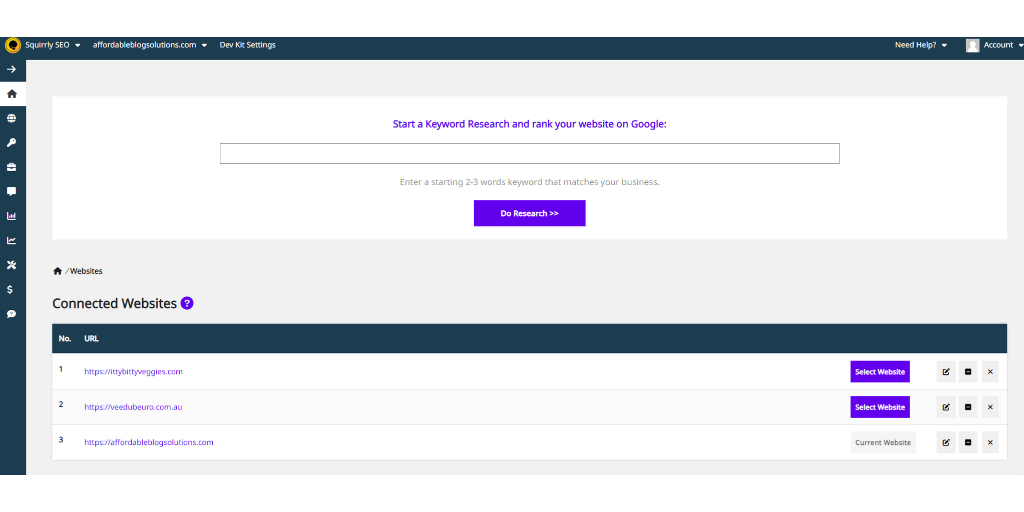
Squirrly Main Features
The Squirrly cloud tool is limited compared to the WordPress plugin, but there’s still a lot you can do, including keyword research. site audits, and keyword tracking. The keyword research function is more of a search for longtail keywords with lower search volume but less competition.
Keyword data is limited to a difficulty score, search volume, and an idea of how many online discussions on sites like Twitter and Facebook take place around that phrase. If you have ever used advanced research tools like SEMRush, Squirrly’s keywords research feature will feel a little cramped. However, it’s serviceable for website owners with no other options.
Squirrly works best for people who are not experts in SEO as it assists you in producing content that is search engine friendly. The SEO writing tool is not as advanced as other tools in this list. It won’t grade your content against your competitors in the SERPs, for instance. Nor will it collect a list of semantically related phrases.
What it does do is grade you on how well optimized the article is for your primary keyword, but you can feed the software more than one phrase. You are scored based on how well you use SEO best practices such as using the keyword in the H1 and H2 header tags, and how many times you mention the phrase versus your text length to avoid an over-optimization penalty.
Squirrly can work well with other SEO content research software by combining your carefully constructed blog article with Squirrly’s Focus Page feature. A focus page analyzes a bunch of SEO metrics and tells you how well you are doing with color-coded circles.
For example, a red circle in the snippet section could mean you have missed putting the keyword in the title or meta description. Click on the circle to access your list of to-dos and work your way through them. Once you have a checkmark on each task, the circle will turn green and you can move on to the next task.
Squirrly is a powerful SEO tool, [affiliate link] and for just $30USD a month, you gain access to a great bunch of tools that can help you rank your website, get more traffic, and generate more leads through perfectly optimized content.
WriterZen SEO and Content Editor Software and Keyword Research Tool
The extensive keyword research, AI assistant, content outliner, and SEO optimization features of WriterZen could make it an all-in-one SEO optimization suite to flesh out your SEO content strategy and get months of article ideas in one sitting.
The software has been around since 2018 after first being made available to the Southeast Asia market. It has since enjoyed a global release and has become a highly respected tool for thousands of content creators and SEO experts alike who would like to create more SEO-friendly content. Let’s go over the main features.
WriterZen Main Features
Topic Discovery – When you aren’t sure what to write about you can head to the topic discovery tool. Here you can create a list of tons of topic ideas in a matter of minutes. Type in your seed keyword, which you can make pretty broad. WriterZen goes through the top 100 search results for your phrase and clusters the articles into a range of topics for you to explore.

Keyword Explorer – Unlike many other SEO content writer software solutions, WriterZen includes a robust keyword research tool with a unique feature that helps you find easy-to-rank keywords at the click of a button.
Type in your seed phrase to get a list of keyword ideas. Clicking on a keyword will give you more information, including the Search Volume, SERP Overview (top 10 results), WriterZen’s Keyword Difficulty score, Cost Per Click (CPC), trend chart, and a Keyword Data section where you can conduct more research to find easy rank keywords.
All-In-Title – This feature is one of the most useful keyword tools. Unlike keyword difficulty scores, which are usually based on a proprietary algorithm and therefore different between applications, all-in-title is an unambiguous metric that tells you how many people have targeted that exact phrase in their H1 header.
Access to the all-in-title metric is gained with the Golden Filter function, which automatically performs the Keyword Golden Ratio calculation on each keyword. You will consume keyword credits to access this function, but it’s a huge time saver in finding keywords you stand a chance to rank.
Keyword Insights – The Insights tab is useful for topic ideas as well. WriterZen automatically organizes content ideas into categories like How, DO, Does, and What. It’s an excellent tool to help you write an answer to the common questions people are asking in the search engines.
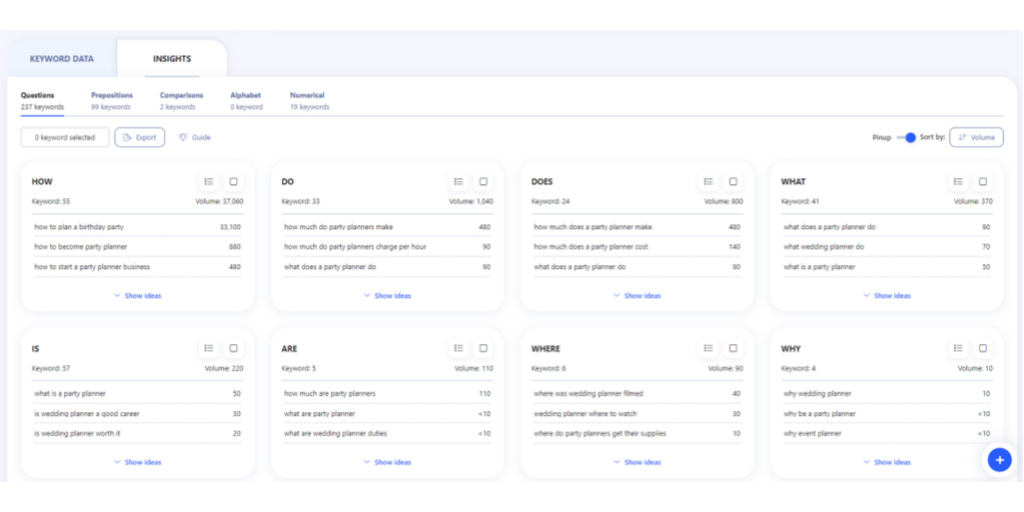
Keyword Clustering Tool – The WriterZen clustering tool is another great time-saving feature that will help you avoid keyword cannibalization (targeting the same keyword in multiple articles). You can import a list of up to 3,000 keywords to automatically organize them into related topics. Create an article around each cluster, and you can potentially rank the same article for a variety of keywords, as well as improve your site’s relevance in the search engines.
Google NLP Phrases – The NLP phrases are not included in any of the monthly plans. Instead, you can purchase NLP one-time credits as you need them. These credits don’t expire and each NLP list will consume three (about $1.00), which could get expensive if you’re a freelancer creating tens of articles a month for your clients.
Content Creator – After using WriterZen’s many keyword research features you are ready to start creating your SEO content. Enter your seed phrase, the writer’s name, and whether you want to gather a list of NLP terms. You also have an optional field to enter more details about the article, such as instructions to the writer.

The next stage takes you into the outline creator where you can select your headers to optimize your content based on how your competitors have structured their articles. WriterZen will also give you information about how many words your competitors have used, when their articles were last updated, insights on what people ask, online discussions, and Reddit topics.
WriterZen’s Basic plan gives you access to everything WriterZen has to offer without limitations. Limits increase with each tier, so you only buy what you need. You can also purchase one-time use credits for keyword research and NLP lists.
I am a freelance SEO content writer on Fiverr and enjoy finding and using the best SEO content writing software that is more affordable and comes with generous limits that make them useful for more people who are just starting out. The above tools are all excellent for producing affordable SEO content that I regularly use in my work. if you have a favorite content analysis tool to help your content rank let us know in the comments and thanks for reading.
